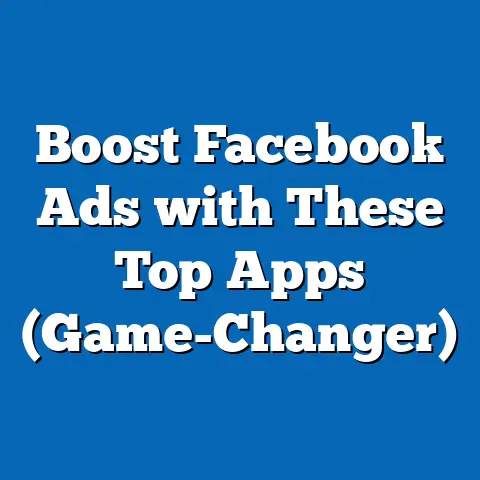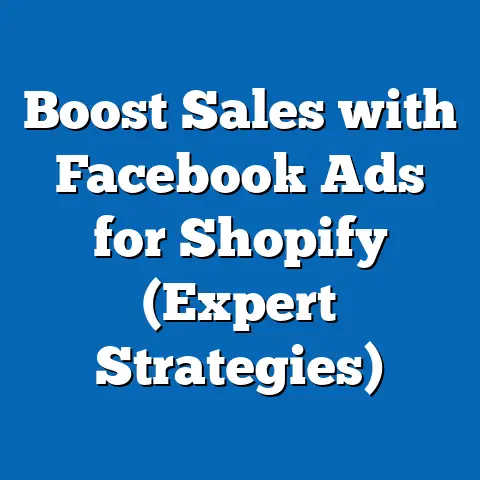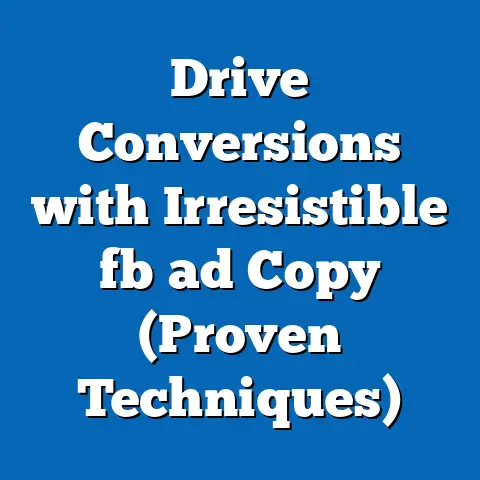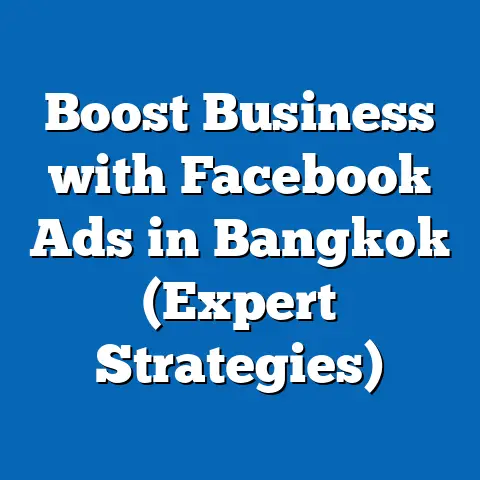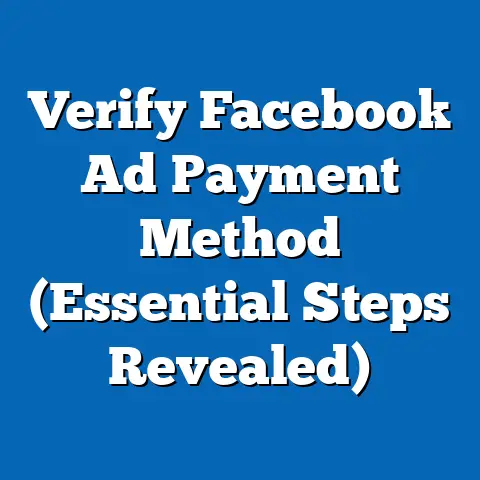Maximize Group Reach on Facebook (Expert Advertising Tactics)
The world of social media advertising can feel like a treacherous ocean. Just when you think you’ve mastered the tides, a new wave of algorithm changes crashes over you, threatening to capsize your carefully crafted campaigns. Businesses are constantly battling for attention, vying for a sliver of the ever-shrinking organic reach on platforms like Facebook. In this digital arena, a strong presence isn’t just nice to have; it’s the life raft that keeps you afloat. But what if I told you there’s a hidden goldmine within Facebook, a place where engagement thrives and organic reach isn’t just a pipe dream? I’m talking about Facebook groups.
Too often overlooked by advertisers, Facebook groups offer an incredible opportunity to connect with your audience on a deeper level, fostering loyalty and driving conversions. But simply creating a group and hoping for the best isn’t enough. To truly unlock the power of Facebook groups, you need a strategic approach, a set of expert tactics that will elevate your group engagement and visibility. So, buckle up, because I’m about to take you on a deep dive into the world of Facebook group advertising, revealing the secrets to maximizing your reach and achieving unprecedented results. Get ready to transform your Facebook advertising strategy and tap into a community of engaged, loyal customers just waiting to connect with your brand.
The Power of Facebook Groups
Facebook groups aren’t just another social media feature; they’re a unique ecosystem that thrives on community and shared interests. Unlike standard Facebook pages, where content often gets lost in the noise, groups offer a more intimate and focused environment. This distinction is crucial for businesses looking to build lasting relationships with their audience.
Think of it this way: a Facebook page is like a billboard on a busy highway – lots of people see it, but few stop to engage. A Facebook group, on the other hand, is like a cozy coffee shop where people gather to chat, share ideas, and connect over shared passions.
Statistics paint a compelling picture of the power of Facebook groups. According to Facebook’s own data, there are over 10 million Facebook groups worldwide, with billions of users actively participating. What’s even more impressive is the engagement rate within these groups. Studies have shown that group members are significantly more likely to interact with content, comment, and share their thoughts compared to users on standard pages. This heightened engagement translates to increased brand awareness, loyalty, and ultimately, conversions.
I’ve personally witnessed the transformative power of Facebook groups firsthand. Early in my career, I worked with a small online retailer selling handmade jewelry. We were struggling to gain traction with traditional Facebook advertising. Our page posts were barely reaching anyone, and our ad campaigns were yielding disappointing results. Frustrated, we decided to experiment with creating a Facebook group dedicated to jewelry enthusiasts.
The results were astounding. Within weeks, the group had grown to thousands of members, all eager to share their love for jewelry, ask questions, and connect with fellow enthusiasts. We started posting content that resonated with the group’s interests, showcasing our unique designs and sharing tips on jewelry care. The engagement was incredible. Members were constantly commenting, sharing photos of their own jewelry collections, and tagging their friends.
But the real magic happened when we started using the group to gather feedback and involve members in the design process. We would post sketches of new designs and ask for their opinions. We even ran polls to determine which styles were most popular. This not only gave us valuable insights but also made the group members feel like they were a part of our brand.
The impact on our sales was undeniable. Our revenue skyrocketed, and our customer base became incredibly loyal. We had transformed a struggling business into a thriving community-driven brand, all thanks to the power of Facebook groups.
This experience taught me a valuable lesson: Facebook groups aren’t just a marketing tool; they’re a platform for building genuine relationships with your audience.
Several successful brands have also recognized the potential of Facebook groups. For example, Instant Pot has cultivated a massive Facebook group with millions of members who share recipes, tips, and support for each other. This group has become a valuable resource for Instant Pot users, fostering brand loyalty and driving sales. Similarly, Sephora has created a Facebook group called “Beauty Insider Community” where members can ask questions, share makeup tips, and connect with beauty experts. This group has become a go-to destination for beauty enthusiasts, solidifying Sephora’s position as a leader in the industry.
Key Takeaway: Facebook groups offer a unique opportunity to connect with your audience on a deeper level, fostering community, loyalty, and driving conversions. Don’t underestimate the power of this often-overlooked feature.
Next Step: Identify potential topics for your own Facebook group that align with your brand and target audience.
Understanding Your Audience
Before you start bombarding your Facebook group with promotional content, it’s crucial to understand who your audience is and what they’re looking for. This isn’t just about knowing their demographics; it’s about understanding their interests, pain points, and motivations.
Think of it like this: you wouldn’t walk into a room full of strangers and start pitching your product without first getting to know them, would you? The same principle applies to Facebook groups.
One of the most valuable tools for understanding your audience is Facebook Insights. This powerful analytics platform provides a wealth of data about your group members, including their demographics, interests, and engagement patterns. By analyzing this data, you can gain valuable insights into what resonates with your audience and tailor your content accordingly.
For example, you might discover that a significant portion of your group members are interested in a particular topic or have a specific pain point. This information can then be used to create content that addresses their needs and interests.
Another valuable technique for understanding your audience is to actively solicit feedback. Encourage group members to share their thoughts and opinions through polls, surveys, and open-ended questions. Pay attention to the comments and discussions within the group, and look for patterns and trends.
Creating buyer personas is another effective way to understand your target audience. A buyer persona is a semi-fictional representation of your ideal customer, based on research and data about your existing and potential customers. By creating detailed buyer personas, you can gain a deeper understanding of their motivations, goals, and challenges.
I remember working with a client who was struggling to understand their Facebook group audience. They had created a group dedicated to fitness enthusiasts, but their engagement rates were low, and they weren’t seeing the results they had hoped for.
We decided to conduct a thorough audience analysis using Facebook Insights and feedback tools. What we discovered was that the group members weren’t just interested in general fitness topics; they were specifically interested in weightlifting and strength training.
Armed with this knowledge, we began to tailor our content to meet the specific needs and desires of the group audience. We started posting articles and videos about weightlifting techniques, nutrition tips for strength training, and interviews with professional bodybuilders.
The results were dramatic. Engagement rates soared, and the group became a vibrant community of weightlifting enthusiasts. The client was able to establish themselves as a trusted authority in the niche and drive significant sales of their weightlifting-related products.
This experience highlighted the importance of understanding your audience and tailoring your content to meet their specific needs.
Key Takeaway: Understanding your audience is crucial for creating content that resonates with them and drives engagement. Use Facebook Insights, feedback tools, and buyer personas to gain a deeper understanding of their interests, pain points, and motivations.
Next Step: Analyze your existing Facebook group data using Facebook Insights to identify key trends and insights about your audience.
Crafting Compelling Content
Once you understand your audience, the next step is to create content that captivates them and keeps them coming back for more. This isn’t just about churning out generic blog posts or promotional materials; it’s about creating content that is engaging, informative, and relevant to your audience’s interests.
Think of it like this: you’re not just selling a product or service; you’re selling an experience, a story, a connection.
The types of content that work best in Facebook groups include:
- Engaging posts: These can include questions, polls, quizzes, and thought-provoking statements that spark conversation and encourage group members to share their thoughts and opinions.
- Videos: Videos are a highly engaging form of content that can be used to showcase your products, share tips and tutorials, or tell your brand’s story.
- Live sessions: Live sessions offer a unique opportunity to connect with your audience in real-time, answer their questions, and build a sense of community.
Storytelling is a powerful tool for creating compelling content. Share your brand’s journey, your successes, and your challenges. Let your audience see the human side of your business.
I’ve found that authenticity is key to building trust and credibility with your audience. Don’t try to be someone you’re not. Be genuine, be transparent, and be yourself.
I remember working with a non-profit organization that was struggling to raise awareness for their cause. They were posting generic updates on their Facebook page, but their engagement rates were low, and they weren’t seeing the results they had hoped for.
We decided to try a different approach. We started sharing stories about the people they were helping, highlighting their struggles, their triumphs, and their hopes for the future. We used powerful visuals to bring these stories to life.
The impact was immediate. Engagement rates soared, and people started donating to the organization in droves. They had connected with the audience on an emotional level, and that had made all the difference.
This experience taught me that content isn’t just about information; it’s about connection. It’s about telling stories that resonate with your audience and inspire them to take action.
Visuals are also essential for enhancing engagement and driving conversations. Use high-quality images and videos to capture your audience’s attention and make your content more appealing.
Key Takeaway: Create content that is engaging, informative, and relevant to your audience’s interests. Use storytelling, authenticity, and visuals to connect with your audience on an emotional level and inspire them to take action.
Next Step: Brainstorm a list of content ideas that align with your audience’s interests and your brand’s values.
Strategic Posting Techniques
Creating great content is only half the battle. To truly maximize your reach within Facebook groups, you need to employ strategic posting techniques. This involves understanding the optimal times for posting, the right frequency, and the balance between promotional and value-driven content.
Think of it like this: you wouldn’t plant seeds without considering the weather, the soil, and the time of year, would you? The same principle applies to Facebook posting.
One of the most important factors to consider is the optimal time for posting. Studies have shown that engagement rates vary depending on the time of day and the day of the week. Experiment with different posting times to see what works best for your audience.
I’ve found that mornings and evenings tend to be the most effective times for posting, as people are more likely to be checking their Facebook feeds during these times. However, it’s important to consider your audience’s specific habits and adjust your posting schedule accordingly.
Frequency is another important factor to consider. You don’t want to bombard your audience with too much content, but you also don’t want to be too infrequent, as this can cause them to forget about you.
I recommend aiming for a consistent posting schedule, such as posting once or twice a day. However, it’s important to monitor your engagement rates and adjust your frequency accordingly.
The balance between promotional and value-driven content is also crucial. You don’t want to be constantly pushing your products or services on your audience. Instead, focus on providing valuable content that is informative, entertaining, and helpful.
I recommend following the 80/20 rule, which suggests that 80% of your content should be value-driven, while only 20% should be promotional.
The “Rule of Seven” in marketing suggests that potential customers need to see or hear your marketing message at least seven times before they take action. While this rule isn’t a hard and fast law, it highlights the importance of consistent exposure. In the context of Facebook groups, this means engaging with your audience regularly, providing valuable content, and subtly reinforcing your brand message over time.
Tactical advice on using polls, questions, and user-generated content can also spark conversations and engagement. Polls are a great way to gather quick feedback from your audience and gauge their interest in different topics. Questions can encourage group members to share their thoughts and opinions, fostering a sense of community. User-generated content, such as photos, videos, and testimonials, can add authenticity and credibility to your brand.
I remember working with a restaurant that was struggling to attract customers to their new location. They had created a Facebook group dedicated to foodies in the area, but their engagement rates were low, and they weren’t seeing the results they had hoped for.
We decided to implement a strategic posting schedule, focusing on posting engaging content during peak hours. We also incorporated polls, questions, and user-generated content to spark conversations and engagement.
The results were dramatic. Engagement rates soared, and the restaurant started seeing a steady stream of new customers. They had transformed their Facebook group into a thriving community of food lovers, all thanks to strategic posting techniques.
Key Takeaway: Maximize your reach within Facebook groups by employing strategic posting techniques. Understand the optimal times for posting, the right frequency, and the balance between promotional and value-driven content.
Next Step: Create a content calendar that outlines your posting schedule, content topics, and posting times.
Leveraging Facebook Ads for Groups
While organic reach within Facebook groups can be significant, leveraging Facebook ads can amplify your reach and drive even more engagement. Facebook ads offer a powerful way to promote your group content and increase membership, reaching a wider audience and targeting specific demographics.
Think of it like this: organic reach is like word-of-mouth marketing – it’s effective, but it’s limited. Facebook ads are like a megaphone – they allow you to amplify your message and reach a larger audience.
When using Facebook ads to promote group content, it’s important to carefully consider your targeting options. Facebook offers a wide range of targeting options, including demographics, interests, behaviors, and custom audiences.
I’ve found that targeting people who are already interested in your niche or industry is a particularly effective strategy. This can be done by targeting people who have liked similar pages or who have expressed interest in relevant topics.
Ad formats are also an important consideration. Facebook offers a variety of ad formats, including image ads, video ads, carousel ads, and collection ads. Experiment with different ad formats to see what works best for your audience.
I’ve found that video ads tend to be particularly effective, as they are highly engaging and can be used to tell your brand’s story. However, it’s important to create high-quality videos that are visually appealing and relevant to your audience.
Budget considerations are also crucial. You don’t want to spend all your money on ads without seeing a return on investment. Start with a small budget and gradually increase it as you see positive results.
I recommend setting a daily budget and monitoring your ad performance closely. If you’re not seeing the results you had hoped for, adjust your targeting, ad format, or budget.
Integrating organic and paid strategies can amplify your reach even further. For example, you can use Facebook ads to promote your best-performing organic content, reaching a wider audience and driving more engagement.
I remember working with a travel agency that was struggling to attract new clients. They had created a Facebook group dedicated to travel enthusiasts, but their membership was low, and they weren’t seeing the results they had hoped for.
We decided to launch a Facebook ad campaign to promote their group and increase membership. We targeted people who were interested in travel, adventure, and specific destinations. We used a combination of image ads and video ads to showcase the group’s content and highlight the benefits of joining.
The results were impressive. Membership skyrocketed, and the travel agency started seeing a significant increase in inquiries and bookings. They had successfully leveraged Facebook ads to amplify their reach and drive business results.
Key Takeaway: Leverage Facebook ads to promote your group content and increase membership, reaching a wider audience and targeting specific demographics.
Next Step: Create a Facebook ad campaign to promote your group content, targeting people who are interested in your niche or industry.
Measuring Success and Adjusting Strategies
Measuring the success of your group engagement tactics is essential for understanding what’s working and what’s not. This involves tracking key performance indicators (KPIs) and analyzing the data to identify areas for improvement.
Think of it like this: you wouldn’t drive a car without looking at the dashboard, would you? The same principle applies to Facebook group engagement.
Some of the most relevant KPIs for Facebook groups include:
- Engagement rates: This measures the level of interaction within your group, including likes, comments, shares, and clicks.
- Membership growth: This tracks the number of new members joining your group over time.
- Conversion metrics: This measures the number of group members who take a desired action, such as visiting your website, making a purchase, or signing up for your email list.
Adopting a mindset of continuous improvement is crucial for long-term success. Regularly analyze your data and identify areas for improvement. Don’t be afraid to experiment with different tactics and strategies to see what works best for your audience.
I’ve found that data analysis is the key to refining your strategies over time. Pay attention to the trends and patterns in your data, and use this information to make informed decisions about your content, posting schedule, and ad campaigns.
I remember working with a clothing retailer that was struggling to see a return on investment from their Facebook group. They were posting regularly, but their engagement rates were low, and they weren’t seeing a significant increase in sales.
We decided to conduct a thorough data analysis to identify the problem. What we discovered was that their content wasn’t resonating with their audience. They were posting generic fashion tips and product promotions, but their audience was more interested in styling advice and personal recommendations.
Armed with this knowledge, we began to tailor their content to meet the specific needs and desires of their audience. We started posting styling guides, outfit ideas, and personal recommendations from their staff.
The results were transformative. Engagement rates soared, and the clothing retailer started seeing a significant increase in sales. They had successfully refined their strategies based on data analysis, leading to improved results.
Key Takeaway: Measure the success of your group engagement tactics by tracking key performance indicators and analyzing the data to identify areas for improvement.
Next Step: Create a dashboard to track your Facebook group KPIs and regularly analyze the data to identify trends and patterns.
Conclusion
Facebook groups represent a paradigm shift in the way businesses connect with their audience. They’re not just a marketing channel; they’re a platform for building genuine relationships, fostering loyalty, and driving conversions. In a world where organic reach is dwindling and attention spans are shrinking, Facebook groups offer a powerful way to cut through the noise and connect with your audience on a deeper level.
But simply creating a group and hoping for the best isn’t enough. To truly unlock the power of Facebook groups, you need a strategic approach, a set of expert tactics that will elevate your group engagement and visibility.
I’ve shared some of the most effective tactics for maximizing group reach on Facebook. From understanding your audience to crafting compelling content, from employing strategic posting techniques to leveraging Facebook ads, these strategies will help you transform your Facebook advertising approach and achieve unprecedented results.
Now it’s time to take action. Implement these expert tactics, experiment with different strategies, and track your results. Don’t be afraid to adjust your approach as needed. The key is to be persistent, be patient, and be willing to learn and adapt.
The opportunities within Facebook groups are vast and untapped. Don’t let this goldmine go to waste. Start today and transform your Facebook advertising strategy into a community-driven powerhouse. The future of Facebook advertising is here, and it’s happening in groups. Are you ready to seize the opportunity?

